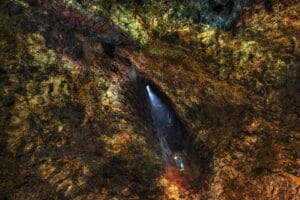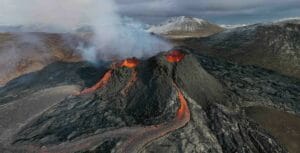Like most countries, Iceland has four beautiful and relishing seasons; Spring, Summer, Autumn, and Winter. Many explorers, travelers, hikers, and campers have their favorite season to visit Iceland to explore the best of landscape, forestry, and scenic beauty. Iceland remains thrilling and picturesque through different seasons, climate, and weather. The northern lights, gigantic mountains, luscious trails, and glamorous rivers look eye-captivating in all seasons.
No matter which month or season you pick to visit a beautiful country, you have plenty of things and options to explore. Each weather unleashes a new and captivating side of Iceland, keeping hikers, travelers, explorers, and travel enthusiasts thrilled and motivated. In Iceland, you’re bound to have an ecstatic experience, exploring this incredible and exciting beauty.

The Truth About Icelandic Weather
The weather of Iceland is not like what its name suggests; its milder, calm, warm, and relaxing. This is mainly due to Gulf streams that flow along with different parts of the country. Like any other country, Iceland has mixed weather conditions in its northern and southern sides. The northern region of Iceland has more damp, cold, and windy due to Atlantic and Arctic cold air, whereas in the south, you will experience warm and humid weather due to heavy rainfalls and winds blow from the Caribbean Sea. Also, before forming a perspective about any type of weather, do remember that you’re in Iceland and in this country you can never predict the weather or climate. It changes every five minutes, so come prepared to get surprised.

The Beautiful Four Seasons
A lot of your journey depends on the weather or season you choose to visit the beautiful scenic place. Due to extreme weather conditions in summer and winters, a lot of attractions are often not accessible, the places either get temporarily closed or are not safe to travel. On the other hand, some great tourist attractions look extremely lethal in a particular season or weather. Most people love to travel to Iceland in summer so that they can enjoy the gorgeous flowers, wild trails, and rhythmic rivers. But for those who love winter sports like skiing, snowboarding, and ice skating or are coming to see the northern lights, winter is the perfect season to visit Iceland for them. Every season has its perks and disadvantages, but the place never compromises on giving you the best dose of a rejuvenating and relaxing experience.
Spring in Iceland

With blooming flowers, migrating birds, and the breathtaking sight of the rugged coastline, create a relaxing and calm ambiance across the country. You can travel across Reykjavik, the capital city of Iceland, and enjoy the city lights along with shopping some souvenir. Though usually warmer weather is expected in spring, you can also experience unpredictable snowfall and storms in May. Do remember to carry along some warm clothes as the temperature can be unpredictable even in spring too.
Summer in Iceland

Summer is the official tourist season in Iceland; the season welcomes thousands of hikers, travelers, campers and explorers. Usually, the month of June and July are considered as the summer months with no nighttime darkness known as the Midnight Sun. During this time, the weather is pleasant, warm, and soothing, offering a great time to tourists in the country.
In summer, people have access to plenty of outdoor activities, including camping, hiking, trekking, horseback riding, swimming, and for those who enjoy indoor activities, the country offers mesmerizing activities like operas and symphony performances. Icelanders enjoy their summer vacation in the scenic beauty and to explore great mountain heights in the wilderness. Remember that it’s never too hot in Iceland due to cooling breezes from Gulf Stream, so bring your warm clothes along with you to the expedition.
Autumn/Fall in Iceland

Around September, the tourist season is known to end abruptly, and many attractions like museums and theaters in the capital city, Reykjavik, close down until the next tourist season. But no season or weather can take away the beauty that lies in Iceland. Visiting Iceland in fall means experiencing all four seasons in one because you will witness abrupt weather shifts. From mild Gulf Streams to heavy rainfalls to stormy winds, you will experience the best and unpredictable weather around this time of the year.
Though October to December is considered as the rainy season in Iceland and visitors do not have access to various outdoor activities, there are still plenty of off-season activities the place has to offer. From musical nights to enlightening orchestra performances, people can remain entertained throughout the season. Due to off-season, the accommodation prices go down, which means you have to pay a lot less to experience some striking autumn colors with a pathway decorated with fallen leaves. You can also have a glimpse of the northern lights and the first snowfall of the year. The weather condition is going to be damp and humid, so carry along some waterproof clothes, a raincoat, and sturdy boots. The muddy ways can be slippery and sloppy, so a pair of functional boots are a must to carry along on your expedition.
Winters in Iceland

A lot of people think that winter is not the most appropriate time to visit Iceland, generally because of the cold and unpredictable weather. But the country looks magnificent when covered in a white blanket of snow and peaking sun; it is a dramatic moment that one can capture for the rest of its life. Though the weather gets dramatically majestic, it’s an absolute treat for those who love winter sports like skiing, ice skating, snowboarding, and snowballing. The gigantic mountains look stunning when covered with snow, and the warm Gulf Streams creates a cozy and soothing ambiance. Winter is a perfect season for those who love to live on the edge and to try some crazy, adventurous stuff. Winter in Iceland is not as bad as it sounds because of the name; it is quite milder and reasonable if we prepare ahead. Due to less daylight in winter, it is important to have a plan; every time you visit a place, be it trekking or camping in the wilderness, make sure you have access to all the necessary items and equipment. If you’re adamant to visit Iceland in winter then pack along with you warm layers of clothes, extra food, safety equipment, and sturdy winter boots.
Experience Different Weather in Each Month
Throughout the year, Iceland experiences a variety of weathers that potentially determines your visit to the beautiful country:
- In January, the weather is freezing and calls for layers of woolen clothes, gloves, boots, and coats. If you’re all about the sparkling lights and cool breezes than January is your month to travel to Iceland.
- February usually has 7 to 10 hours of daylight, which means you can cover more significant distance while sightseeing. If you’re planning to drive through the trails this month, then keep an eye on the road conditions as they can be sloppy and risky.
- By March, the daylight conditions rapidly get better, and you love to experience some heartthrob sunrises and sunset, and this is the month for you.
- April is usually an off-season month but perfect for those who want to experience the mesmerizing beauty on a budget.
- Known for better weather and longer days, May is among the most popular months with unpredictably hotter and rainier days.
- Traveling in June means staying up late to relish the Midnight Sun and digging into hot spring bathing.
- Make sure to catch the sight of the most beautiful and jaw-dropping sunsets while traveling to Iceland in July. The weather is moist, warm, and cozy, offering you a comfortable and peaceful stay.
- In August, the nights started to get a lit bit cold, demanding layers of warm clothes. It is usually the last month of summer and brings an end to the tourist season.
- With eye-captivating fall colors, September becomes the perfect season for travelers that wants to experience a tinge of both summer and winter.
- October allows individuals to experience cozy and comfortable evenings and nights in delightful cafes, theaters, and hotel rooms. The weather is windy and dusky, which means it is not as pleasant to experience many outdoor activities.
- If you love dressing warm and all about unleashing beautiful winter mornings, then traveling to Iceland in November is undoubtedly a thing to try!
- December is known to be among the darkest months in Iceland because of less or no daylight. You cannot experience many outdoor activities like hiking and camping due to heavy snowfalls, but the northern lights and Christmas holidays are a charming combination.
The Best Time to Travel to Iceland
To determine in which season or month you should travel to Iceland is probably the toughest thing you have to plan throughout your trip. Every season or month has different weather and climate that determines what activities you choose to get entertained in Iceland. Remember, if you’re traveling to Iceland for the first time, try to keep it simple and not experiment with the season or month you choose. If it is your first time, prefer visiting the beautiful and awe-inspiring beauty in summers as you get more people around you to guide you throughout your little adventurous journey.
To many people, Iceland is a place covered with the dramatic natural landscape, gigantic mountains and perfect playground for hikers and campers. Less people have hiked or camped around the country in winters due to increased risk and unfavorable weather conditions. So, it is essential to pick which side you want to unleash, are you adventurous enough to uncover the winter wilderness, or do you want to go subtle with exploring the calm and relaxing summertime. Also, a lot of people want to explore everything in one season, which is next to impossible; you just can have a glimpse of Northern Lights and Midnight Sun in the same season or weather.
If you are into hiking and outdoor activities, then April to August is the perfect time to visit Iceland, and on the other hand, if you’re into exploring the crazy and thrilling winter sports, then traveling in winter (From November to March) can be your cup of tea. Remember each month offers different weather and, each month, you’ve access to various attractions and places that you want to unleash in your trip. Determining all these factors can be tricky but essential while traveling to Iceland. For those who want to save their pocket, traveling in the off-season can be a great option, the prices are low, and there are not a lot of people around to disturb you while enjoying the mesmerizing and relishing beauty.
Weather is an important decisive factor in the travel expedition to Iceland. With four different seasons and unpredictable weather, it is always essential to plan for everything that can come along your way. No one really can control the weather or climate of a particular place, but what you can do to be safe is to keep an eye on the favorable and unfavorable environment. By checking the forecast, you can decide what things you need to pack for a hiking or camping. You can also determine what clothes you want while traveling to a particular place. Keeping an eye on forecast means preparing yourself for the worst possible weather that can hinder your journey to the wilderness.
It is generally believed that weather circumstances are dependent upon an individual’s perspective. If you’re okay with rains or if you love rain, then traveling in rainfalls will not be a problem for you. Similarly, if you love striking colors and love the crackling sound of the dried leaves, then going in autumn can be your thing. It is totally upon what you expect from the place and what you want to experience that depends on which weather or season you should travel in.
Another thing that determines your trip to beautiful Iceland is the attractions that you wish to see. The accessibility of certain attractions or places depends upon the time you are traveling in, e.g. it is impossible to enjoy the Northern Lights in summer or the month of June and July because of no nighttime darkness. Similarly, some popular hiking destinations like Thorsmörk Valley and Mount Esja Trail is not open for hikers and travelers in winter due to heavy snowfall and increased chances of land sliding.

















































